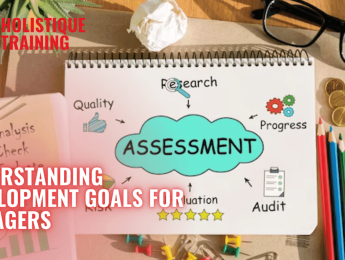- Table of Contents
- Introduction
- What Is Participative Management?
- Advantages of the Participative Management Style
- Enhanced Decision-making
- Increased Employee Engagement, Motivation, and Satisfaction
- Fostering a Culture of Trust and Collaboration
- Improved Problem-solving and Innovation
- Enhanced Employee Development
- Strengthening Organisational Resilience
- Characteristics of a Participative Manager
- 1. Effective Communication Skills
- 2. Empathy and Respect for Employees
- 3. Delegation and Empowerment
- 4. Flexibility and Adaptability
- 5. Courageous Decision-making
- 6. Visionary Outlook
- Steps to Becoming a Participative Manager
- 1. Foster a Culture of Trust and Openness
- 2. Involve Employees in Decision-making
- 3. Provide Training and Development Opportunities
- 4. Recognise and Reward Employee Contributions
- 5. Lead by Example
- 6. Encourage Continuous Feedback
- 7. Promote Collaboration Beyond Your Team
- 8. Evaluate and Iterate
- Key Performance Indicators (KPIs) for Participative Management
- 1. Employee Satisfaction Scores
- 2. Employee Engagement Levels
- 3. Productivity Metrics
- 4. Innovation Rates
- 5. Customer Satisfaction Ratings
- 6. Employee Retention Rates
- 7. Conflict Resolution Efficiency
- 8. Knowledge Transfer and Cross-Functional Collaboration
- 9. Employee Development and Skill Enhancement
- Digital Tools and Participative Management
- Participative Management and Diversity & Inclusion
- 1. Embracing Diverse Perspectives
- 2. Fostering a Culture of Belonging
- 3. Enhancing Decision-making with Diverse Teams
- 4. Building a Reputation for Social Responsibility
- 5. Enhancing Creativity and Problem-solving
- 6. Addressing Unconscious Bias
- 7. Cultivating Empathy and Cultural Competence
- Conclusion
Introduction
Various leadership styles have emerged in the ever-evolving landscape of business management. One approach that has gained significant recognition is participative management. It emphasises collaboration, inclusivity, and shared decision-making within an organisation. This blog post explores the concept of participative management, its advantages, the characteristics of a participative manager, and the steps to becoming one. By embracing this management style, organisations can tap into the collective wisdom of their employees, fostering a culture of innovation, engagement, and overall success.
What Is Participative Management?
Participative management, also known as democratic or inclusive management, is a leadership approach that encourages active involvement and input from employees at all levels of an organisation. In this style, decisions are made collectively, and employees are given a voice in the decision-making process. Participative management acknowledges that employees possess valuable insights and expertise, which can contribute to the organisation's overall success.
Advantages of the Participative Management Style
Participative management isn’t just a theoretical concept; it’s a transformative approach redefining how organisations operate. By actively engaging employees in the decision-making process, participative management unleashes a myriad of advantages that significantly impact the organisation's dynamics and outcomes:
Enhanced Decision-making
In the realm of participative management, decisions cease to be the prerogative of a select few. Instead, they become a collective endeavour, drawing from the diverse pool of knowledge, skills, and experiences that employees bring to the table. This diversity catalyses innovation. Imagine a brainstorming session where a marketing expert, a data analyst, and a customer service representative collaboratively devise a strategy. Such interdisciplinary discussions often lead to ingenious solutions that a traditional top-down management approach might miss. The decisions made under participative management are not just informed; they are comprehensive and considerate of various aspects, making them resilient in the face of challenges.
Increased Employee Engagement, Motivation, and Satisfaction
Participative management empowers employees, making them feel valued and respected. Employees who are given a sense of ownership and responsibility become more engaged and motivated to perform at their best. This heightened engagement often leads to increased productivity and job satisfaction. In fact, according to LinkedIn, numerous organisations that embrace participative management witness a remarkable level of job satisfaction among their employees, with the majority expressing high levels of contentment.
Fostering a Culture of Trust and Collaboration
Trust is the glue that binds a team together, and participative management catalyses its formation. In an environment where every opinion is valued and considered, trust flourishes. Employees feel secure in voicing their thoughts, ideas, and even concerns. This open dialogue nurtures a culture where collaboration isn’t just encouraged; it's ingrained in the organisational DNA. When team members trust each other and their leaders, communication flows seamlessly. This trust extends to customers and partners, creating a ripple effect that strengthens the organisation's reputation. Trust becomes the cornerstone upon which enduring professional relationships are built, setting the stage for sustainable success.
Improved Problem-solving and Innovation
Every problem is an opportunity, and participative management transforms challenges into avenues for innovation. When employees from varied backgrounds collaborate, their perspectives collide, creating a spark of creativity. Problems that might seem insurmountable to a single mind become puzzles waiting to be solved collectively. Participative management nurtures an atmosphere where ideas are cherished, mistakes are viewed as stepping stones, and curiosity is celebrated. This conducive environment fosters a culture of continuous improvement. Through brainstorming sessions, hackathons, or even casual conversations, employees often stumble upon revolutionary ideas that can reshape products, services, or even entire industries.
Enhanced Employee Development
Empowering employees to participate actively in decision-making is akin to providing a real-time leadership workshop. They hone essential leadership skills as they engage in discussions, defend their viewpoints, and analyse outcomes. Delegated responsibilities sharpen their decision-making abilities, enabling them to assess risks and strategies, and execute plans. This hands-on experience is invaluable for their professional growth, making them better-equipped leaders for future roles. Moreover, the exposure to diverse situations and challenges under participative management broadens their perspectives, nurturing adaptive and agile leaders who can navigate the complexities of the modern business landscape.
Strengthening Organisational Resilience
In today’s volatile business landscape, adaptability is not just a quality; it's a survival skill. Participative management, by its very nature, promotes flexibility and openness to change. Employees become accustomed to adaptability when they are part of the decision-making process. They understand that change is not a threat but an opportunity for growth. Consequently, the organisation becomes resilient, capable of weathering storms and emerging stronger on the other side. Participative management equips the organisation with a proactive mindset, ensuring it stays ahead of the curve and embraces change as a natural evolution rather than a disruption.
In essence, participative management is a beacon guiding organisations towards a future where collaboration is not just a strategy; it’s a way of life. By reaping the benefits of this approach, organisations can craft a workplace where creativity, trust, engagement, and innovation thrive. It’s not merely a management style; it’s a philosophy that transforms workplaces into vibrant ecosystems where every individual’s potential is unlocked, leading to unparalleled organisational success.
Characteristics of a Participative Manager
Participative management isn’t solely a structural change in an organisation; it’s a cultural shift that necessitates adept and empathetic leaders. A participative manager isn’t just a decision-maker; they are the orchestrators of collaboration, the nurturers of trust, and the catalysts of innovation. Let’s delve into the essential characteristics that define a participative manager and make them the linchpin of a thriving, inclusive workplace:
1. Effective Communication Skills
Participative managers are adept communicators. They possess the ability to articulate their vision with clarity, ensuring every team member understands the organisational goals and expectations. However, their communication prowess extends beyond just talking. They are active listeners, patiently absorbing diverse viewpoints. Through active listening, participative managers foster an environment where employees feel heard, valued, and understood. Clear communication builds trust, ensuring that information flows seamlessly, and aligning everyone toward common objectives.
2. Empathy and Respect for Employees
Empathy is the cornerstone of participative management. Participative managers genuinely care about their team members’ well-being. They invest time in understanding their challenges, aspirations, and concerns. Participative managers create a supportive atmosphere by acknowledging the human element of the workplace. They respect the diverse backgrounds, perspectives, and experiences of their employees. This respect is not just a formality; it’s a genuine acknowledgement of the richness that diversity brings to the organisation. By embracing diversity, participative managers set the stage for inclusive decision-making, where every voice is valued, irrespective of hierarchy or background.
3. Delegation and Empowerment
Participative managers understand the power of delegation. They don’t just delegate tasks; they delegate responsibilities and the authority to make decisions within defined boundaries. By empowering employees, participative managers instil a sense of ownership. Employees are no longer just task executors; they contribute to the organisation’s success. This empowerment nurtures their confidence and skills, encouraging them to take initiative and contribute meaningfully. Participative managers provide guidance when necessary but also trust their employees’ judgement, allowing them to thrive in an environment that values autonomy.
4. Flexibility and Adaptability
In the dynamic landscape of modern businesses, change is inevitable. Participative managers embrace change not as a disruption but as an opportunity for growth. They are open to new ideas, experiments, and modifications based on feedback and evolving circumstances. This flexibility filters down to the entire team, creating an agile environment where everyone is prepared to adapt swiftly to changing market demands. Participative managers understand that rigid structures hinder innovation, so they encourage their team to think outside the box, experiment, and learn from failures, fostering a culture of continuous improvement.
5. Courageous Decision-making
Participative managers possess the courage to make tough decisions. They balance the inclusivity of participative management with the firmness needed to steer the ship in the right direction. While they seek input and feedback, they are not afraid to make decisions, especially in critical situations. Their decisions are well-informed, considering the team's collective wisdom while aligning with the organisation's overarching goals. This balanced approach instils confidence in the team, assuring them that their manager can make decisive choices when necessary, providing a sense of direction and stability amidst uncertainties.
6. Visionary Outlook
Participative managers possess a visionary outlook. They understand how individual participation aligns with the broader organisational objectives. They don’t just involve employees for the sake of inclusivity; they strategically channel their contributions toward achieving specific goals. This strategic alignment ensures that purposeful participative efforts lead to tangible outcomes. Participative managers communicate the bigger picture to their team, allowing every participant to understand how their input contributes to the organisation’s success. This clarity of purpose motivates employees, ensuring their participation is not just enthusiastic but also focused and goal-oriented.
In essence, a participative manager isn’t just a leader; they are the architects of a collaborative utopia within the organisation. Through their communication skills, empathy, empowerment, adaptability, decision-making acumen, and visionary leadership, they craft an environment where every team member feels valued, empowered, and motivated to contribute their best. Participative managers don’t just manage; they inspire, nurture, and lead by example, paving the way for an organisation where participation isn’t just a management style but a way of life.
Steps to Becoming a Participative Manager
Becoming a participative manager is a journey that involves a deliberate shift in mindset and approach. It’s not just about changing decisions; it’s about fostering a culture of collaboration and inclusion within your team and organisation. Here are the key steps to becoming a participative manager and guiding the transformation effectively.
1. Foster a Culture of Trust and Openness
Trust is the bedrock of participative management. As a manager, you must create an atmosphere where trust can thrive. Be transparent, honest, and approachable. Encourage open dialogue within your team, where every member feels safe to express their thoughts, ideas, and concerns. Actively listen to your employees, showing genuine interest in their perspectives. Constructive feedback should be welcomed and viewed as an opportunity for growth, both for individuals and the team. When trust permeates your team, it sets the stage for meaningful participation.
2. Involve Employees in Decision-making
Actively involving employees in the decision-making process is the essence of participative management. Organise brainstorming sessions, team meetings, and collaborative problem-solving exercises. Encourage everyone to contribute ideas, share their viewpoints, and challenge existing notions. Make it a habit to seek diverse perspectives before making important decisions. This not only harnesses the collective intelligence of your team but also makes every member feel valued and heard. Inclusive decision-making instils a sense of ownership and responsibility among employees, fostering active engagement.
3. Provide Training and Development Opportunities
Investing in the growth and development of your employees is crucial for participative management. Offer training programmes, workshops, and mentoring opportunities to enhance their skills and knowledge. Empower them with the tools and resources necessary to contribute effectively to the decision-making process. Training equips them with technical expertise and hone their communication, problem-solving, and critical-thinking skills. Well-trained employees are confident and more inclined to participate actively in discussions and decision-making processes.
4. Recognise and Reward Employee Contributions
Acknowledging and appreciating the efforts of your team members is fundamental. According to Apollo Technical, a recent survey found that 37% of employees prioritise recognition. Implement recognition and reward systems that celebrate employee achievements. This reinforcement not only boosts morale but also reinforces the value of employee input. Recognition can be in various forms, such as verbal praise, certificates, or even small tokens of appreciation. When employees feel that their efforts are recognised and celebrated, they are motivated to continue actively participating, fostering a culture of continuous engagement.
5. Lead by Example
As a participative manager, you must lead by example. Participate actively in discussions, demonstrate open-mindedness, and showcase your willingness to listen to others’ ideas. Encourage teamwork, collaboration, and knowledge-sharing among your team members. Show that you value and respect everyone’s input, regardless of position or experience. Your behaviour sets the tone for the entire team. When employees see their manager actively engaging in collaborative efforts, they are more likely to follow suit, creating a culture where participation becomes a norm rather than an exception.
6. Encourage Continuous Feedback
Establish a system for regular feedback, both for yourself and your team. Encourage employees to provide feedback on the participative processes. What works well? What needs improvement? Act on this feedback, making necessary adjustments to enhance the participative approach. Additionally, provide constructive feedback to your team members individually, guiding them on improving their participation. Feedback loops are invaluable for continuous learning and adaptation, ensuring that participative management practices evolve with the changing needs of your team and organisation.
7. Promote Collaboration Beyond Your Team
Extend the culture of collaboration beyond your immediate team. Encourage interdepartmental collaborations and knowledge sharing. Facilitate cross-functional projects and initiatives where employees from different departments can work together. By promoting collaboration at an organisational level, you create a network of shared knowledge and expertise. This interconnectedness fosters a sense of belonging and unity, making every employee feel like a vital part of the larger organisational ecosystem.
8. Evaluate and Iterate
Regularly evaluate the effectiveness of participative management within your team. Use key performance indicators (KPIs) like employee engagement levels, innovation rates, and productivity metrics to assess the impact of participative practices. Based on the evaluation, identify areas for improvement and implement changes accordingly. Remember, participative management is not a one-size-fits-all approach; it should be tailored to suit the unique dynamics of your team and organisation. Continuously iterate on your participative practices, aiming for continuous improvement and creating an environment where participation becomes a natural and integral part of the organisational culture.
In short, becoming a participative manager is about embracing a mindset of inclusivity, openness, and collaboration. By fostering a culture of trust, involving employees in decision-making, providing growth opportunities, recognising contributions, leading by example, encouraging feedback, promoting collaboration, and continuously evaluating and improving, you can guide your team and organisation toward a future where participative management isn’t just a practice but a way of working and thriving together. You can transform your team into a hub of innovation, engagement, and excellence through these deliberate steps.
Key Performance Indicators (KPIs) for Participative Management
In the realm of participative management, success isn’t just a subjective feeling—it's a quantifiable phenomenon. Measuring the impact of participative management is essential to understanding its effectiveness, making data-driven decisions, and continuously enhancing the process. Key Performance Indicators (KPIs) act as the compass, guiding organisations to assess the influence of participative management practices on various aspects of the workplace. Here’s how organisations can measure the impact of participative management through strategic KPIs:
1. Employee Satisfaction Scores
Employee satisfaction scores are a fundamental KPI that reflects how content and fulfilled employees are within the organisation. Implement regular surveys to measure employee satisfaction levels, specifically asking questions about their involvement in decision-making processes. A steady increase in satisfaction scores over time indicates that participative management practices resonate positively with the workforce. Satisfied employees are more likely to be engaged, motivated, and productive, contributing significantly to the organisation’s overall success.
2. Employee Engagement Levels
Engagement levels quantify how actively employees participate in their work and the organisational processes. High engagement levels indicate that participative management encourages employees to actively contribute ideas, engage in discussions, and collaborate effectively. Track metrics such as participation rates in team meetings, brainstorming sessions, and suggestion programmes. An upward trend in engagement levels signifies that employees are involved in decision-making and enthusiastic about participating, fostering a vibrant and dynamic workplace culture.
3. Productivity Metrics
Participative management, when executed effectively, can positively impact productivity. Monitor productivity metrics such as project completion rates, task turnover times, and overall efficiency. A rise in productivity, coupled with participative management initiatives, indicates that involving employees in decision-making processes is not hindering productivity but enhancing it. Engaged employees, empowered to make decisions, tend to take ownership of their tasks, leading to increased efficiency and timely project deliveries.
4. Innovation Rates
Innovation is a direct outcome of diverse perspectives and collaborative thinking. Track the number of innovative ideas employees generate, especially those implemented and contributing to the organisation’s growth. Innovative solutions, products, or services from participative management efforts demonstrate that employees’ creative potential is harnessed effectively. Regular brainstorming sessions, suggestion boxes, or innovation contests can be mechanisms to encourage employees to share their innovative ideas, providing tangible data on the impact of participative management on organisational creativity.
5. Customer Satisfaction Ratings
The impact of participative management isn’t limited to the internal workings of the organisation; it extends to customer satisfaction as well. Customer satisfaction ratings provide valuable insights into how well the organisation meets customer expectations. Engaged and empowered employees, driven by participative management, are more likely to effectively understand and address customer needs. Monitor customer satisfaction scores over time, correlating them with periods when participative management initiatives were introduced or intensified. Positive trends in customer satisfaction indicate that employees, empowered to make decisions, are delivering better customer experiences.
6. Employee Retention Rates
Participative management plays a crucial role in retaining top talent. Engaged employees who are actively involved in decision-making processes are more likely to feel valued and committed to their roles. Track employee retention rates and analyse whether there is a correlation with participative management practices. Lower turnover rates among employees indicate that participative management fosters a positive work environment where employees are motivated to stay, reducing recruitment costs and maintaining a stable, experienced workforce.
7. Conflict Resolution Efficiency
Participative management often leads to open communication and collaborative problem-solving, positively impacting conflict resolution efficiency. Monitor the time taken to resolve conflicts within teams and assess whether participative decision-making has facilitated smoother conflict resolution. Reduced conflict resolution times indicate that employees are comfortable expressing their concerns and that issues are addressed promptly and effectively through collaborative dialogue, enhancing overall team dynamics.
8. Knowledge Transfer and Cross-Functional Collaboration
Participative management encourages knowledge-sharing and cross-functional collaboration. Track the frequency and efficiency of knowledge transfer between departments or teams. Improved collaboration and seamless knowledge transfer indicate that participative management practices are breaking down silos, fostering a culture of openness and information exchange. This interconnectedness ensures that knowledge is disseminated effectively, leading to a more informed, skilled, and adaptable workforce.
9. Employee Development and Skill Enhancement
Participative management contributes significantly to employee development. Measure employees' progress in skill enhancement programmes, training sessions, or workshops. Analyse whether employees who actively participate in decision-making processes demonstrate higher growth rates regarding skills and competencies. Improved skill enhancement rates among participating employees indicate that they are involved in strategic decisions and actively enhancing their skills, becoming more versatile and valuable assets to the organisation.
Digital Tools and Participative Management
In today’s digital age, various tools and technologies facilitate participative management, transcending geographical boundaries and time zones. Collaborative platforms, project management software, and virtual meeting tools empower employees to engage in decision-making processes regardless of their location actively. These digital solutions enhance communication and collaboration and promote inclusivity, ensuring that every team member’s voice is heard regardless of their physical presence.
Tool | Features | Benefits |
Slack | Real-time messaging and file sharing | Enhanced communication and team collaboration |
Trello | Kanban-style project management | Visual project tracking and task organisation |
Microsoft Teams | Chat, video meetings, and file sharing | Seamless integration with Microsoft Office tools |
Zoom | Video conferencing and webinar hosting | High-quality virtual meetings and presentations |
Google Workspace | Collaboration suite with various apps | Real-time document editing and shared calendars |
Table 1: Comparison of Popular Digital Tools for Participative Management
Participative Management and Diversity & Inclusion
Diversity and inclusion are not just buzzwords; they are the cornerstones of a progressive, innovative, and resilient organisation. When coupled with participative management, these principles create a powerful synergy, reshaping the very fabric of the workplace culture.
1. Embracing Diverse Perspectives
Diversity in the workplace encompasses differences in race, ethnicity, gender, age, sexual orientation, abilities, experiences, and perspectives. Participative management actively encourages the involvement of individuals from diverse backgrounds in decision-making processes. When employees with varied life experiences and viewpoints collaborate, the result is a tapestry of ideas and innovations. Diverse perspectives challenge the status quo, prompting deeper discussions and creative problem-solving. Inclusivity ensures that every voice is heard, ensuring a more comprehensive understanding of issues, fostering innovative solutions, and enhancing the organisation's adaptability to change.
2. Fostering a Culture of Belonging
Inclusion goes beyond merely involving people; it's about creating a sense of belonging. Participative management, when coupled with a commitment to diversity and inclusion, makes every team member feel valued and respected. When employees see their ideas being acknowledged and considered, irrespective of their background, they develop a sense of ownership in the organisation’s success. A workplace where diverse voices are actively engaged is a workplace where employees are more engaged, committed, and motivated. This sense of belonging enhances teamwork, productivity, and overall job satisfaction, creating a positive cycle of mutual respect and collaboration.
3. Enhancing Decision-making with Diverse Teams
Diverse teams, empowered by participative management, make decisions that are more robust and comprehensive. In fact, according to LinkedIn, 87% of the time, diverse teams outperform in decision-making. Homogeneous groups tend to suffer from groupthink, where similar perspectives dominate, leading to narrow-minded decision-making. However, when diverse individuals participate in decision-making processes, a wide array of ideas and viewpoints are considered. This diversity ensures a balanced evaluation of options, leading to more informed and well-rounded decisions. Such decisions are not only reflective of the organisation’s diverse customer base but also demonstrate a commitment to fairness and equality.
4. Building a Reputation for Social Responsibility
Organisations that prioritise diversity, inclusion, and participative management are perceived as socially responsible entities. In today’s socially conscious world, such organisations become magnets for top talent. A diverse and inclusive workplace, coupled with participative management practices, showcases the organisation’s commitment to equality and fairness. Prospective employees are more likely to be attracted to organisations that value their individuality and offer an inclusive environment where they can actively participate, share ideas, and contribute meaningfully.
5. Enhancing Creativity and Problem-solving
Studies have consistently shown that diverse teams are more creative and better at problem-solving. When individuals from varied backgrounds collaborate, their unique perspectives lead to innovative solutions. Participative management nurtures an atmosphere where diverse ideas are not only welcomed but also actively sought. This diversity in thought processes and problem-solving approaches enhances the organisation's ability to adapt to challenges and find inventive solutions, giving it a competitive edge in the market.
6. Addressing Unconscious Bias
Participative management coupled with diversity and inclusion initiatives creates a platform to address unconscious biases. By actively encouraging diverse voices, organisations can break down stereotypes and prejudices. When decisions are made collectively, based on merit and ideas rather than preconceived notions, it challenges biassed thinking patterns. The awareness of these biases and the active steps taken to mitigate them create a workplace where individuals are evaluated for their skills, knowledge, and contributions, fostering an environment of fairness and equality.
7. Cultivating Empathy and Cultural Competence
Participative management within a diverse workforce nurtures empathy and cultural competence. As employees interact and collaborate with colleagues from different backgrounds, they develop a deeper understanding of varied cultures, traditions, and perspectives. This understanding enhances interpersonal relationships, promotes mutual respect, and strengthens the organisational culture. Employees become more culturally aware and adept at navigating diverse environments, both within the organisation and in interactions with external stakeholders, making the organisation more globally competitive and culturally sensitive.
In essence, participative management and diversity & inclusion are not isolated strategies; they are interconnected threads that, when woven together, create a tapestry of empowerment, innovation, and harmony. By actively engaging diverse voices through participative management, organisations foster an inclusive, collaborative, and compassionate workplace culture. This culture not only benefits the employees but also propels the organisation toward excellence, ensuring that it remains at the forefront of progress and social responsibility. Through this dynamic synergy, organisations not only thrive but also set new benchmarks for ethical, inclusive, and participative leadership in the corporate world.
Conclusion
Participative management is a powerful leadership style that unlocks the potential of employees, enhances decision-making, and fosters a culture of engagement and innovation. By embracing this approach, managers can create a workplace where every voice is heard, and employees are empowered to contribute their best. The advantages of participative management are far-reaching, leading to increased employee satisfaction, improved problem-solving, and organisational success. By developing the characteristics of a participative manager and following the steps outlined in this blog post, organisations can harness the collective intelligence of their workforce and unlock their full potential. However, if you need help perfecting your management and leadership skills, we’ve got you covered. Just get in touch with us now or enrol in our comprehensive course below!























